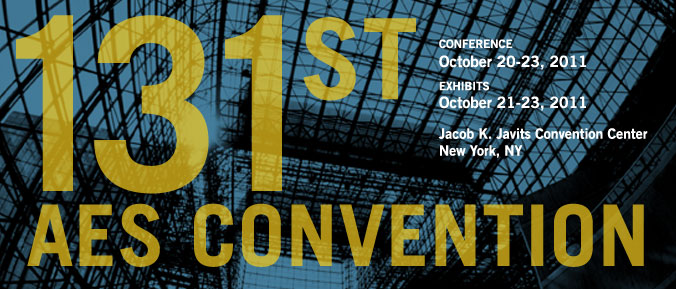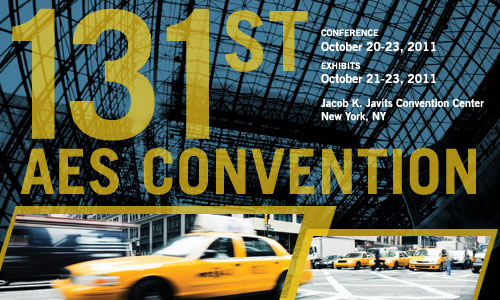
AES New York 2011
Paper Session P25
P25 - Auditory Perception
Sunday, October 23, 3:00 pm — 5:30 pm (Room: 1E09)
Chair:
Richard King, McGill University - Montreal, Quebec, Canada, Centre for Interdisciplinary Research in Music, Media and Technology, Montreal, Quebec, Canada
P25-1 The Impact of Producers’ Comments and Musicians’ Self-Evaluation on Performance during Recording Sessions—Amandine Pras, Catherine Guastavino, McGill University - Montreal, Quebec, Canada
When recording in the studio, musicians repeat the same musical composition over and over again without the presence of an audience. Furthermore, recording technologies transform the musical performance that musicians hear in the studio. We conducted a field experiment to investigate whether record producers’ comments and musicians’ self-evaluation helped musicians improve from one take to another during recording sessions. Twenty-five jazz players, grouped into five ensembles, participated in recording sessions with four record producers. Two types of feedback between takes were varied independently: with or without comments from a record producer and with or without musicians’ self-evaluation after listening to the takes in the control room. Our results show that both external comments and self-evaluation give the ensemble a common ground but also make musicians too self-conscious.
Convention Paper 8579 (Purchase now)
P25-2 The Influence of Camera Focal Length in the Direct-to-Reverb Ratio Suitability and Its Effect in the Perception of Distance for a Motion Picture—Luiz Fernando Kruszielski, Toru Kamekawa, Atsushi Marui, Tokyo University of the Arts - Tokyo, Japan
In order to study the possible influence of a camera focal length in the auditory distance perception, two experiments were conducted. In the first experiment, participants were asked to adjust the amount of reverb according to the presented visual image, which had different focal lenses distances, and therefore different backgrounds. In the second experiment, participants were asked to rate the egocentric sense of distance to the sound source and the suitability of the sound for the visual image in a pairwise comparison. The results have shown that the overall sense of distance is mainly dependent on the focal length; however, if the image foreground object has the same size, the focal length can alter the perception of sound distance.
Convention Paper 8580 (Purchase now)
P25-3 Automatic Soundscape Classification via Comparative Psychometrics and Machine Learning—Krithika Rajagopal, University of Miami - Coral Gables, FL, USA, Audio Precision, Beaverton, OR, USA; Phil Minnick, Colby Leider, University of Miami - Coral Gables, FL, USA
Computational acoustical ecology is a relatively new field in which long-term environmental recordings are mined for meaningful data. Humans quite naturally and automatically associate environmental sounds with emotions and can easily identify the components of a soundscape. However, equipping a computer to accurately and automatically rate unknown environmental recordings along subjective psychoacoustic dimensions, let alone report the environment (e.g., beach, barnyard, home kitchen, research lab, etc.) in which the environmental recordings were made with a high degree of accuracy is quite difficult. We present here a robust algorithm for automatic soundscape classification in which both psychometric data and computed audio features are compared and used to train a Naive Bayesian classifier. An algorithm for classifying the type of soundscape across different categories was developed. In a pilot test, automatic classification accuracy of 88% was achieved on 20 soundscapes, and the classifier was able to outperform human ratings in some tests. In a second test classification accuracy of 95% was achieved on 30 soundscapes.
Convention Paper 8581 (Purchase now)
P25-4 Effect of Whole-Body Vibration on Speech. Part II: Effect on Intelligibility—Durand Begault, NASA Ames Research Center - Mofett Field, CA, USA
The effect on speech intelligibility was measured for speech where talkers reading Diagnostic Rhyme Test material were exposed to 0.7 g whole body vibration to simulate space vehicle launch. Across all talkers, the effect of vibration was to degrade the percentage of correctly transcribed words from 83% to 74%. The magnitude of the effect of vibration on speech communication varies between individuals, for both talkers and listeners. A “worst case” scenario for intelligibility would be the most “sensitive” listener hearing the most “sensitive” talker; one subject’s intelligibility was reduced by 26% (97% to 71%) for one of the talkers.
Convention Paper 8582 (Purchase now)
P25-5 Some New Evidence that Teenagers May Prefer Accurate Sound Reproduction—Sean Olive, Harman International Industries, Inc. - Northridge, CA, USA
A group of 18 high school students with no prior listening experience participated in two separate controlled listening tests that measured their preferences between music reproduced in (1) MP3 and lossless CD-quality file formats, and (2) music reproduced through four different consumer loudspeakers. Overall, the teenagers preferred the sound quality of the CD-quality file format, and the most accurate, neutral loudspeaker. Together, these tests provide some new evidence that teenagers can discern and appreciate a better quality of reproduced sound when given the opportunity to directly compare it against lower quality options.
Convention Paper 8583 (Purchase now)
Information Last Updated: 20111005, mei

